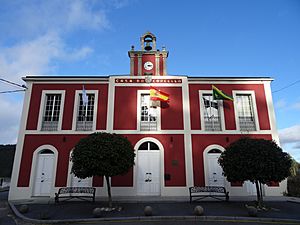Ourol facts for kids
Ourol is a small town, also called a municipality, located in the Lugo province of Spain. It's part of an area known as A Mariña Occidental. In 2009, about 1,157 people lived there.
Contents
Where is Ourol Located?
Ourol covers an area of about 145.4 square kilometers. It is divided into eight smaller areas called parishes. These parishes are:
- Ambosores (Santa María)
- Bravos (Santiago)
- Merille (Santa Eulalia)
- Miñotos (San Pedro)
- Ourol (Santa María)
- San Pantaleón de Cabanas (San Pantaleón)
- O Sisto (Santa María)
- Xerdiz (Santa María)
Ourol shares its borders with other towns. To the north, you'll find Viveiro and Vicedo. Muras is to the south. Valadouro is to the east, and Mañón is to the west.
How Has Ourol's Population Changed?
Demography is the study of how populations change over time. Ourol's population has changed quite a bit. For example, in 1910, over 6,300 people lived there. By 2010, the number had dropped to around 1,146 people. This shows a big decrease in the number of residents over many years.
A Look at Ourol's Past
Ourol has a long and interesting history, with signs of people living there from very early times.
Early Stone Age in Ourol
The Paleolithic period is the earliest part of the Stone Age. For a long time, not much was known about this period in Galicia, where Ourol is. However, experts believed that people lived here even during the Ice Ages. In the 1920s, stone tools were found in nearby areas. Later, between the 1960s and 1980s, more discoveries were made. These findings showed that people lived in the region during both the Paleolithic and Mesolithic (Middle Stone Age) periods. In Ourol, a special site called Xestido in Miñotos was found. It had tiny, sharp stone tools, showing early human activity.
Giant Stone Monuments: Megalithic Culture
The Megalithic culture is famous for building large stone monuments, often for burials. These are called mounds or dolmens. In Ourol, several of these ancient mounds have been found:
- A Veiga in San Pantaleon de Cabanas: This is a round mound, covered in plants. It's about 12 meters wide and 1.30 meters tall. It might have had a stone chamber inside.
- Penido Vello/Huchas de Penido Vello: This mound is about 16 meters wide and 130 centimeters tall. It still has part of its original stone chamber and cover.
- Mound 1 de Pena do Toxo
- Mound 2 de Pena do Toxo
- Mounds de Monte Cristo dos Callós: This is a group of seven mounds, forming an ancient burial ground.
Images for kids
See also
In Spanish: Orol para niños



